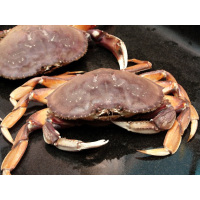Put that Dungeness and Rock Crab Down, Now
 Dungeness crab
Dungeness crab
The California Department of Public Health (CDPH) really knows how to ruin the start of crab season.
On Monday, the department warned consumers not to eat Dungeness and Rock crab caught between the Oregon border and Santa Barbara because of potentially deadly levels of the neurotoxin domoic acid. No one has been reported ill from it yet, but high levels of domoic acid have turned up in samples of crabs.
Domoic acid accumulates in seafood when it encounters a “bloom” of the single-celled plant Pseudo-nitzschia. The toxin is resistant to heat, so even boiling the crab doesn’t kill it. Domoic acid can cause vomiting, diarrhea, abdominal cramps, headache, dizziness, short-term memory loss, seizures and death.
The largest algal bloom in more than a decade has been lurking off the coast for months. The National Oceanic and Atmospheric Administration (NOAA) was saying in June that it’s not unusual to see patches of bloom in the spring, but the size and concentration was unusual and disruptive of normal marine life patterns.
Vera Trainer, manager of the Marine Microbes and Toxins Program at the Northwest Fisheries Science Center (NWFSC) in Seattle called it “unprecedented in terms of the extent and magnitude.” It peaked in late summer.
California consumers were warned back then by the National Oceanic and Atmospheric Administration (NOAA) not to eat “recreationally harvested mussels and clams, commercially or recreationally caught anchovy and sardines, or the internal organs of commercially or recreationally caught crab taken from Monterey and Santa Cruz counties.”
The CDPH is running tests on crab beds and results are due this week. Crab season begins on Saturday and thousands of fishermen participate, along with their partying family members at campgrounds and other venues near the ocean. The industry brings in around $200 million a year.
While the toxin’s presence is rough on crab lovers, it is even tougher on other animal life. “The sea lions and the birds don’t pay attention to the warnings, so they’re the ones that are really being impacted,” University of California, Santa Cruz, Professor Raphael Kudela told ThinkProgress in June. Neither do whales, fish and shellfish.
“It’s much more a wildlife concern at the moment than a human health concern,” he said.
Although the go-to explanation for the huge bloom was climate change and resulting warmer waters, the CDPH said, “The conditions that support the growth of this plant are impossible to predict, and it is unknown when the levels found in crab will subside.”
–Ken Broder
To Learn More:
Don’t Eat Dungeness Crab, California Health Department Warns (by Nanette Asimov, San Francisco Chronicle)
California’s Dungeness Crab Season Start in Doubt Due to Toxic Algae Offshore (by Mary Callahan, Santa Rosa Press Democrat)
Dungeness Crab: Toxic Algae Could Delay Northern California Season (by Aaron Kinney, Bay Area News Group)
“Unprecedented” Toxic Algal Bloom Closing Fisheries on the West Coast (by Ken Broder, AllGov California)
CDPH Issues Warning about Dungeness and Rock Crabs Caught in Waters Along the Central and Northern California Coast (California Department of Public Health)
- Top Stories
- Controversies
- Where is the Money Going?
- California and the Nation
- Appointments and Resignations
- Unusual News
- Latest News
- California Forbids U.S. Immigration Agents from Pretending to be Police
- California Lawmakers Urged to Strip “Self-Dealing” Tax Board of Its Duties
- Big Oil’s Grip on California
- Santa Cruz Police See Homeland Security Betrayal in Use of Gang Roundup as Cover for Immigration Raid
- Oil Companies Face Deadline to Stop Polluting California Groundwater





